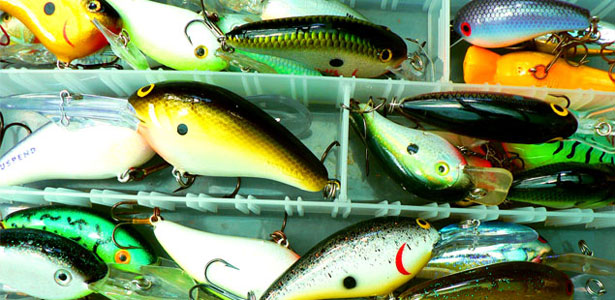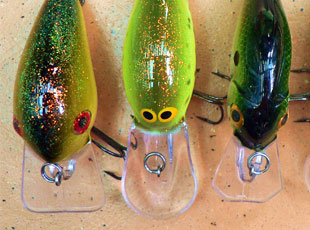 All bass fishermen have thrown a crankbait at one time or another. These baits have come a long way over the years and have probably received the most attention when it comes to improved technology since Laurie Rapala hand carved his first wooden minnow back in the 1930’s. Today they are one of the most advanced bass baits around with photo finish coatings, internal rattle chambers, ‘dive-to’ technology and realistic swimming actions that cover a vast range of depths and situations.
All bass fishermen have thrown a crankbait at one time or another. These baits have come a long way over the years and have probably received the most attention when it comes to improved technology since Laurie Rapala hand carved his first wooden minnow back in the 1930’s. Today they are one of the most advanced bass baits around with photo finish coatings, internal rattle chambers, ‘dive-to’ technology and realistic swimming actions that cover a vast range of depths and situations.
Although crankbaits are considered reaction lures, unlike spinnerbaits, they do hold a far more realistic and natural appeal as a food source for bass. In fact there are many times that crankbaits will out fish other lures on a regular basis and have become the “go to” baits for many top pros under many situations, especially when it comes to deeper water during the hotter months. However, although they seem like easy throw-and-wind type fish catchers that come in pretty colours, they are probably also the least understood of bass baits when it comes to fishing them effectively.
Crankbaits are most effective when they are fished around the depth they were designed for; it’s the angle, width and length of the bill that determines the bait’s effective swimming depth. Those with straighter, wider bills protruding horizontally with the bait body and at right angles off the nose will dive deeper than those with shorter, downward angled lips. The position of the line tie can also affect the diving depth and crankbaits with the line tie positioned closer to the head will generally dive deeper than those with the line tie positioned further along the bill. The position of the line tie can also dictate the amount of action the bait emits on the retrieve, and baits with the line tie positioned closer to the face, will usually produce a tighter wobble. The body shape of a crankbait is also something to take into consideration, where fatter baits generally create more of a rolling, side-to-side wobble and slimmer profiles a tighter, faster action.
 So, considering all the above, how do we choose an effective crankbait for the situation? Firstly we would need to acquire a selection of crankbaits that will allow us to cover the water column for any situation. This would mean shallow runners for water from around 1 to 4 feet, medium depth cranks for the 4 to 12 foot zone, and of course deep runners for depths of 12 feet and more. Crankbaits are generally calibrated for a depth zone as opposed to a specific depth, and this is usually to allow for various line sizes to be used. In clearer, warmer water such as we usually find during spring and autumn, a thinner bodied crankbait that emits a tighter, faster action on the retrieve would be a good place to start, as bass will generally be active, using sight and responding quite aggressively to an energetic bait.
So, considering all the above, how do we choose an effective crankbait for the situation? Firstly we would need to acquire a selection of crankbaits that will allow us to cover the water column for any situation. This would mean shallow runners for water from around 1 to 4 feet, medium depth cranks for the 4 to 12 foot zone, and of course deep runners for depths of 12 feet and more. Crankbaits are generally calibrated for a depth zone as opposed to a specific depth, and this is usually to allow for various line sizes to be used. In clearer, warmer water such as we usually find during spring and autumn, a thinner bodied crankbait that emits a tighter, faster action on the retrieve would be a good place to start, as bass will generally be active, using sight and responding quite aggressively to an energetic bait.
In more stained or murkier water such as we usually find in the summer months a crankbait that has a wider, slower wobble will allow active bass to more easily home in on the bait. A good tip to remember when considering running depth, is to select a bait that runs a little deeper than the depth you are fishing. This not only gets the bait down quicker to the strike zone but also allows the bait to ‘skoot’ along and make contact with the cover, deflecting off rocks, stumps or logs and drawing good reaction bites. This is very effective if you find yourself having to fish deeper in summer, for example, where if you are fishing in water 10 foot deep you can select a bait that has a running depth of 11 to 12 feet that also allows for some forgiveness in your line size. The true running depth of your crankbait is usually linked with the thinnest diameter of line, so as mentioned heavier line will affect the overall performance and running depth of your crankbait. There are situations, for example, over submerged grass or weed beds where you might not want your bait to dive to the maximum depth, but rather to a depth that allows the bait to skim just over the top, drawing bass out of the cover. This of course can be achieved by selecting a shallower running crankbait or by increasing your line size.
Like with most moving or reaction baits that have a natural built- in action, you can catch fish by merely casting out and reeling in, but crankbaits are far more effective if you give the bass something to think about. Bass are opportunists and are more likely to react instinctively to an easy meal than to one which looks healthy and hard to catch, which is why your crankbait needs to move in a way that mimics a wounded, feeding or isolated baitfish. Make no mistake, there are times when bass will hammer your crankbait no matter how fast or straight you reel it, but it’s usually the smaller bass. More often than not to get more and better quality fish to bite you need to get that bait to do something different, be it slowing down, speeding up, jerking it, suspending it or bouncing it off cover. It takes time on the water and some experimentation to develop an effective retrieve pattern and it’s important to allow the bass to tell you what is going to work on any given day.
Although crankbaits are designed to work straight out of the packaging it is often beneficial to test them and see which ones perform better. I have encountered situations where a particular bait, although the same brand, identical in size, running depth and colour, just seemed to be more attractive to bass than the other. This is especially true with the more buoyant wooden baits and it can take some time to identify the ones that do something different and just seem to catch more fish. These baits can become valuable in your fishing arsenal and really help with confidence as go-to baits. Testing crankbaits can be done in a swimming pool where you can see how your bait behaves under different retrieve styles and speeds. This will also allow you to check the bait’s tracking angle and often you will need to tune a crankbait so that it runs straight and true. This can be achieved with some needle nose pliers by gently bending the line tie. For example if the bait is tracking to the left you can very carefully bend the line tie to the right until the bait tracks straight back towards you, and vice versa. This is something that is obviously done with care so as not to damage this vital connection to the fish. There are exceptions to this in some situations where you might want your crankbait to purposefully track to one side. For example this could be when trying to get your bait to run under a dock, an overhang or some type of surface weed like lily pads. However to start out you want to build an arsenal of crankbaits that you have confidence in, that run true and cover the water column effectively to meet many situations.
Summer is a great time to target deeper bass with crankbaits on channel drop offs, points, ledges, humps or other deeper structures where there is a pronounced depth change and close to shallower feeding areas. During summer soon after post-spawn, the bass’ metabolism reaches full swing, baitfish are generally high on the bass’ list and deep cranking becomes highly effective right through to the onset of early winter. Depending on the water you are fishing, deep could be anything from 6 feet to anywhere around 20 feet; deeper than that and crankbaits become more difficult to keep in the zone and that’s when Carolina rigs, jigs and other presentations become more effective. This is where gear and presentation becomes important and as crankbaits dive at an angle towards you and not vertically, it’s crucial to make long casts past your selected area, get the bait down ahead of the strike zone, bring it through and keep it there for as long as possible. If you are too close or too far from the spot your crankbait will miss the zone or not make contact with the cover when either descending or ascending on the retrieve, which makes marker buoys and depth electronics valuable tools. Once a potential hot spot has been located on the finder, for example stumps on the edge of a channel drop at 14 feet, a marker buoy can be deployed as a visual reference. Then you can back away from the spot and make long casts with a crankbait that can reach about 16 feet, around the area making sure that you are reaching and preferably making contact with the cover. As you probe the area around the marker buoy you might need to alter your casting angle on the cover until you find the sweet spot. When you hook a fish another marker buoy can be immediately dropped into the water that will then give you a pretty good visual reference on the angle where you can concentrate more accurate casts. The important thing here is to try and get your bait to bounce and deflect off the cover and stay in the zone for as long as possible. Often if you put in the effort to locate some potential spots like this you can really hone in on some good bass bunched up in these areas and be well on your way to establishing a strong pattern. If you manage to catch a few good bass off the spot and the action dies off, take the time to GPS the location, which could very well replenish later in the day, or change to a different technique like a dropshot, jig or Carolina to get a few more bites.
Although we all have our favourite brands, designs and colours there are a few things that I look out for when selecting a crankbait and which I think can make a difference in how a bass reacts. Firstly I prefer baits that have a good range of depth and colour combinations that can make matching the hatch and matching to water clarity and conditions a lot easier. I also prefer crankbaits that give special attention to details such as large eyes, splashes of colour in throat, belly and gill areas as well as realistic use of translucency and colour blending. This can be especially true for shallower running crankbaits down to around 6 to 10 feet where I feel that bass will react to these features when using sight in clearer conditions. However, besides colour, in deeper or murkier water it can be the action and sound of a crankbait that gets the bass to react positively. This is where body designs or the roll of a crankbait becomes a factor with fatter baits giving off a wider wobbling action than those with thinner profiles and tighter actions. Many of the plastic crankbaits have built in rattle chambers that help to attract bass but in very clear, shallow conditions can have a negative impact, so have a few wood alternatives for those finicky situations. Although there are many colours to choose from keep it simple, as you will discover that it takes very few colours to catch bass consistently.
Some popular and effective colours for clearer and bright conditions are the natural shad combinations that are usually silver or white with black, brown, green or purple/blue dorsal areas. For low light or murkier conditions firetiger, white/chartreuse, black or brown/chartreuse or blue/chartreuse combinations are effective. In our waters or in water with a muddy stain it is often effective to have some yellow or orange in the belly area. There are a few good alternatives which are also productive in many situations such as the brown crawfish colours, solid white, gold as well as bluegill and redear imitations that closely resemble some of our kurper species. More importantly however, is the confidence you develop in the style of bait and colour you choose.
Tackle
When it comes to gearing up it’s important to use the right tools for the job, which will generally consist of a 7 to 8 foot medium action rod with a good backbone but also a flexible tip or upper section for making long casts and for playing a bass. Although crankbaits are good fish catchers they do have treble hooks that bass tend to throw a lot easier and do not always hold as well as a large single hook, so having a fair amount of flex in the tip of your rod will help keep the hooks embedded when the fight is on, especially close to the boat on a short line. Shorter rods are fine for short distance casting shallow cranks in skinny water around cover but deep cranking, which is usually anything deeper than 6 to 8 feet, usually means longer casts and prolonged fights.
Line choice varies from angler to angler but generally fluorocarbon or monofilament are most commonly used. Monofilament has more stretch, which often helps as an added shock absorber for good bass hooked on small trebles. Fluorocarbon is denser, practically invisible, has minimum stretch but sinks better than mono so is usually the best choice for getting crankbaits to the optimum depth quickly. However what is more important is choosing a line that has optimum strength for the smallest diameter to get the maximum depth from your bait in deep water. Good all round line sizes are anything between 8 and 12 pound test, bearing in mind that line size will effect the performance and diving depth of your crankbait. However, you can use heavier line for fishing shallow or square bills around cover when needing that extra muscle.
Although very effective, crankbaiting can be hard work and will test your endurance, so baitcasting reels are better suited for prolonged cranking, although to begin with you might want to use a slow speed reel to achieve the best results; with a bit of practice and experience you can use higher speed reels and still control your bait speed effectively.


 Visit us our
Visit us our